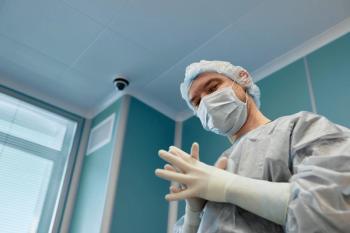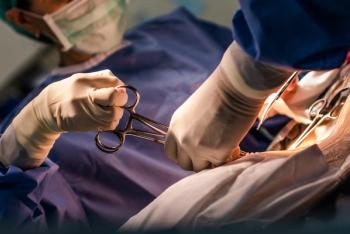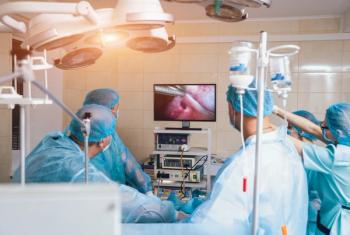
- Vol 65 No 2
- Volume 65
- Issue 02
Was this prolapse properly managed?
In a case with multiple defendants, coordinating defenses should be the primary objective for trial.
Facts
Before being treated by Defendant ob/gyn A, the plaintiff had seen Co-defendant ob/gyn B in January 2013 for worsening symptoms of prolapse. Her complaints included incomplete voiding, urinary frequency, nocturia, urgency two to four times per day, and some rare episodes of stress urinary incontinence (SUI).
Dr. B found that the plaintiff had evidence of Stage II uterovaginal prolapse 1 cm past the hymen. His impression was uterine prolapse, cystocele, rectocele, and urinary incontinence, and a need to rule out voiding dysfunction. The plaintiff’s treatment by Dr. B continued through the winter of 2013, during which various surgical interventions were explained to her. She ultimately gave him consent for a laparotomy, supracervical hysterectomy, bilateral salpingo-oophorectomy (BSO), sacrocolpopexy with permanent mesh, possible cystocele and rectocele repair, and cystoscopy.
The plaintiff underwent surgery with Dr. B at Codefendant Hospital on May 7, 2013. Dr. B discussed the risks of surgery with the plaintiff including possible bowel injury. He encountered significant scarring, which he stated might be secondary to previous obstetrical injury. He did not perform the sacrocolpopexy because of his intraoperative findings of a deep pelvis, pelvic adhesions, redundant bowel, and diverticular disease. In the setting of an obese woman with diabetes, risk of infection and mesh erosion was greater, therefore, he elected to perform a modified colpopexy.
The plaintiff was on disability from May through July 2013 and Dr. B continued to treat her during that period. However, by the August 19, 2013 visit with Dr. B, it appeared that the plaintiff was having recurrence of prolapse. He had a long conversation with her but did not recommend any surgical intervention. The plaintiff’s last visit with Dr. B was on November 18, 2013. He noted she was having chronic constipation, and was not only bothered by vaginal protrusion, but there were days when she felt some discomfort. On exam, Dr. B noted excellent healing of the abdominal incision and no apical approach or cystocele. During maximal straining, a small Stage I rectocele and distal component 2 cm above the hymen was noted. There were no foreign bodies in the vagina and no antrocele. Dr. B instructed the plaintiff to do pelvic floor exercises and to lose weight. He noted that at that time he was very pleased with the results.
On February 24, 2014, the plaintiff presented to Nonparty ob/gyn C and his facility for an assessment of her recurring vaginal prolapse. Dr. C noted that she was a 62-year-old G4P3 who presented with a chief complaint of occasional urgency with leakage. She also admitted to frequency and nocturia but denied urinary leakage with cough, laugh or sneeze (SUI). She reported feeling a bulge and was status post-supracervical abdominal hysterectomy, uterosacral ligament suspension, and posterior repair done in May 2013 at Co-defendant Hospital (by Dr. B). Dr. C indicated that he reviewed those records and that Dr. B had originally consented the plaintiff for a mesh sacral colpopexy, but that intraoperatively, Dr. B decided against the use of mesh.
A review of systems and physical exam were generally within normal limits except that the exterior vaginal wall demonstrated a large cystocele to 1 cm past the introitus, cervix at the level of the introitus, and there was a large rectocele. Bedside cystometrics was also performed and demonstrated a fair sensation at 100; fullness 270, max capacity at 300 with a negative cough stress test, pretest postvoid residual (PVR) of 180, and post-test residue of less than 10. Dr. C’s overall impression was that the plaintiff had a large recurrent prolapse, status post-uterosacral ligament suspension.
Dr. C indicated he had a “long discussion” with the plaintiff. He noted that uterosacral ligament suspensions have a success rate at best in the range of 60% to 80%. Sacral colpopexy would give her a success rate of close to 99%. His note also indicated that the plaintiff would consider having a sacral colpopexy as well as anterior and posterior repair. Dr. C also indicated that he took time to discuss the pros, cons, risks, benefits, success and failure rates of the proposed procedure as well as complications including but not limited to injury to bowel, urinary tract infection (UTI), blood loss, mesh erosion, new onset of incontinence, urinary retention, and need for additional surgery.
Facts (cont'd)
The plaintiff’s treatment with Dr. A began on June 2, 2014. At that time, she was evaluated for symptomatic vaginal prolapse for the past 10 months, which was affecting her lifestyle. Her current complaint was voiding 15 to 20 times per day and twice per night. Dr. A’s conclusion was vaginal vault prolapse post-hysterectomy. Options of conservative observation, pessary placement, and surgery were discussed in detail. Potential risks and complications were also discussed. The plaintiff agreed to undergo a minimally invasive sacrocolpopexy.
On July 14, 2014, the plaintiff underwent a Pelvic electromyogram (EMG) and urodynamics, which showed that her bladder capacity was normal with sphincter coordination. There was urethral hypermobility with SUI. The plaintiff returned to Dr. A’s office on August 18, 2014, and Dr. A suggested a laparoscopic vs. robotic sacrocolpoplasty with midurethral sling. The plaintiff had Stage 3 anterior wall vaginal prolapse (AWVP) and Stage 2 apical prolapse and underwent urethrosacral culpoplasty with Ethibond and Vicryl without sacrocolpopexy, anterior repair perineorrhaphy, supracervical hysterectomy, and BSO in May 2013. Comorbidities included hypertension, diabetes mellitus, hypothyroidism, gastroesophageal reflux disease, and atherosclerosis. She was postmenopausal.
Dr. A documented an exhaustive discussion with the plaintiff regarding the potential risks and complications of the proposed surgery, which included, among other things, risk of infection requiring antibiotics and re-hospitalization, and risk of damage to adjacent organs including but not limited to the bladder, bowel, ureters, and nerves. The plaintiff also signed a general surgery consent form acknowledging that Dr. A explained the potential risks of the procedure in a way that the plaintiff could understand.
On September 3, 2014, the plaintiff presented to Defendant Hospital for surgery. The procedure performed was diagnostic laparoscopy with lysis of adhesions, sacrospinous ligament fixation, anterior repair, laparotomy, enterotomy repair x 2 and cystoscopy. Laparoscopic findings included dense adhesions noted between the small bowel and anterior abdominal wall extending from the umbilicus to the bladder. The adhesions penetrated into the fascia consistent with a ventral hernia and involved the rectal muscle. There were also adhesions between the colon and lateral sidewalls and the small bowel and bladder. Lysis of adhesions was performed for 1.5 hours. A questionable (non-circumferential) partial rectal prolapse was encountered. Cystoscopy revealed proper positioning of the mesh without perforation or ureteral obstruction. An Obtryx sling material was used.
According to Dr. A’s operative report after the abdominal cavity was surveyed:
“Dense adhesions were noted along the anterior abdominal wall between the small bowel, the omentum, and the anterior abdominal wall. Careful dissection was performed with the monopolar scissors mostly without heat, to lyse the adhesions for about 1.5 hours. During this dissection, as we uncovered the adhesions, we discovered that the bowel was densely adhered to the anterior abdominal wall fascia and rectus muscles. Also a 3 mm serosal tear was noted in the small bowel. This was tagged with a vicryl and colorectal was consulted. He agreed this needed oversewing and further lysis of adhesions and that this would be best achieved via an open incision. We converted to a midline incision (chosen based on where the adhesions were). The abdomen was insufflated as we made an incision with the knife and carried it down to the underlying layer of fascia to help protect the bowel. At this point we connected the incision with the ventral midline hernia just inferior to the umbilicus and entered the peritoneal cavity. We extended the incision inferiorly taking care to avoid the bowel adhesions. At this point colorectal surgery scrubbed in and in running the bowel an enterotomy was identified with no frank spillage and he primarily repaired that with vicryl and then oversewed the previously identified serosal tear. He also assisted with the remaining lysis of adhesions.
At this point, the decision was made to not proceed with the sacrocolpopexy due to the concern for a contaminated field due to the enterotomy. I stepped out to discuss the operative findings and plan with her husband and decision was made to proceed with native tissue repair.”
A typed operative report by the Colorectal Surgeon noted that he was called intra-operatively to assess the small bowel. He further noted in his operative report that “during lysis of adhesion, an enterotomy was noted.” There was a serosal tear in the proximal ileum as well as a full-thickness enterotomy in the mid ileum, which was 25% circumferential. The serosal tear and the enterotomy were repaired with interrupted 3-0 Vicryl suture. There were no other intraoperative or postoperative complications and the plaintiff was admitted overnight for observation. Facts (cont'd)
On September 5, 2014, the plaintiff complained of mild soreness at the incision site. However, she was afebrile, voided, and tolerated liquids. She was then discharged home on Oxycodone, Motrin and Senna. She was instructed to continue all prior medications. No antibiotics were prescribed.
The plaintiff followed up with Dr. A’s office on September 9, 2014. She reported that she was voiding, had a bowel movement, and was ambulating. On September 13, 2014, the plaintiff was admitted to the Defendant Hospital with complaints of oozing from the vaginal incision site. Her vital signs were stable and she was afebrile with a pain score of 5/10. She reported 2 days of peri-incisional erythema and separation of the incision on the day of admission. She had called Dr. A’s office and Keflex was prescribed for presumed cellulitis.
The plaintiff had a visible 2-cm abdominal wall incision with 10-cm tunneling above the fascia. Purulent drainage was expelled, drained, and debrided and the wound was packed while in the emergency room. The plaintiff was admitted for wound infection and was started on wet-to-dry dressing changes, Ancef, and Bactrim. Over the next 2 days, her erythema decreased with dressing changes and Gram stain of the drainage showed neither white blood cells nor bacteria. Cultures showed moderate Staph Aureus. The dehiscence was noted to be 2.5 cm deep to fascia and 1.5 cm wide. However, the plaintiff remained afebrile without evidence of sepsis. She was discharged home on September 16, 2014 on oral clindamycin.
On September 22, 2014, the plaintiff was seen by Dr. A after being hospitalized for a wound infection. However, the wound was slowly healing and measured 3 cm deep with some tracking superiorly. Dr. A noted that the plaintiff had no complaints of fever, chills, bulge or incontinence. She was to follow-up in 2 weeks, at which time a pelvic exam would be done.
On September 26, 2014, VNS called Dr. A’s office and reported that there was yellow-green discharge from the wound. However, there was no odor, increased drainage or fever. An office appointment was arranged for the next Monday. The plaintiff returned to Dr. A on September 29, 2014 for a follow-up visit. At that time, her wound was examined and repacked. On October 6, 2014, the plaintiff was seen for a follow-up visit for her wound and for complaints of urinary frequency. At that time, it was noted that her wound was healing and was 2 cm deep and 3 cm long. At the next visit on October 20, 2014, Dr. A noted that the plaintiff’s wound was almost closed. No prolapse was appreciated on exam and estrogen cream was prescribed for atrophic vaginitis.
On October 27, 2014, the wound was noted to be closed and the plaintiff reported no pain or incontinence. At a follow-up visit on February 1, 2015, the plaintiff complained of double voiding and incomplete emptying; she was treated with Macrodantin. At her last reported visit with Dr. A, on March 16, 2015, she complained of rectal bulge (small hemorrhoid noted on rectovaginal exam), “occasional” fecal urgency and “some” incomplete bladder emptying. A bowel regimen was started and she was referred for pelvic floor exercises. On a form entitled “Patient Global Impression of Improvement,” the plaintiff indicated that her postoperative condition was “normal” and that when compared to her preoperative condition she was “much better.”
On July 28, 2015, the plaintiff presented to her private ob/gyn, Dr. E, with complaints of a recurrent prolapse. However, Dr. E’s note includes no exam findings consistent with recurrent prolapse. On November 16, 2015, the plaintiff underwent right carotid endarterectomy at Codefendant University Hospital, which was complicated by transection of the carotid artery. Postoperatively she had a right middle cerebral artery infarction with left hemiparesis. There was no reference to any urologic complaints.
Allegations
The plaintiff alleged that the defendants were negligent in performing a laparoscopy; in causing an enterotomy; in causing the need to perform an exploratory laparotomy and repair; in failing to properly and sufficiently plan the laparoscopy; in failing to perform appropriate preoperative testing to assess adhesions; and in failing to take all measures necessary to prevent any complications from the laparoscopy. Plaintiff argued the procedure should have been commenced open and opposed to laparoscopically. In addition, plaintiff contended Dr. B “botched” the first prolapse repair, leading to the cascade of events that necessitated future surgeries and complications.
As a result of the alleged negligence, the plaintiff asserted injuries including large recurrent prolapse, urgent urinary frequency, nocturia, and loss of services to her husband.
Discovery
The plaintiff testified that Dr. A advised her that when she started the procedure laparoscopically, they came into contact with numerous adhesions which no longer permitted her to perform the surgery as planned. In addition, as a result of the adhesions, her bowel was nicked and ultimately repaired intraoperatively. Since that surgery, she conceded she no longer experiences any type of urinary complaints. In addition, with respect to the prolapse, the plaintiff also testified that following Dr. A’s surgery in September 2014, she no longer experienced any type of bulging or prolapse. She did testify that she had a brief recurrence in or about April of 2015, however, it self-resolved. With respect to the claim for loss of consortium, she testified that following her surgery with Dr. A, her ability to have a physical relationship with her husband was not affected. It was clear that any significant injury she suffered was related to the stroke she suffered in November of 2015.
Dr. B testified that one of the reasons why he decided to do the modified colpopexy, as opposed to the sacrocolpopexy, was because the plaintiff had diverticular disease. According to Dr. B, the plaintiff had a good postoperative course and as of the last time that he saw her, she had a normal vaginal vault and excellent apical suspension.
Dr. A testified that from the time of their first meeting, the plaintiff was insistent on having a sacrocolpopexy. She nevertheless went through a full presentation of the various options available to the plaintiff, including pelvic floor therapy, placement of a pessary, and expectant management. The plaintiff refused those options. Alternative procedures discussed were colpocleisis; use of vaginal mesh; a vaginal approach using uterosacral ligament suspension; and sacrocolpopexy with mesh.
Upon entering the abdomen, Dr. A testified she encountered dense adhesions and, therefore, she called Colorectal Surgery to assist with the lysis of adhesions. She spent 1.5 hours lysing adhesions. At some point she noted a 3-mm serosal tear in the plaintiff’s bowel. Colorectal Surgery recommended that they convert to an open procedure in order to lyse adhesions and inspect the bowels. Both the serosal tear and the enterotomy were repaired with sutures. She cautioned the patient preoperatively about the risk of adhesions and conversion.
We had expert support from Obstetrics and Gynecology, Urogynecology and Colorectal Surgery as to the indications for surgery, the consent provided, the surgical approach and technique, as well as the conversion to open and repair of enterotomies, which were known risks of the procedure and could not be predicted or prevented by testing preoperatively.
Result
At the close of discovery, we moved for Summary Judgment (dismissal) as to our clients. So did counsel for Dr. B. Interestingly, the plaintiff’s counsel did not oppose our motions with an expert of his own, but instead tried to use our experts against each other to suggest that if sacrocolpopexy was not indicated when Dr. B operated, then it was a departure for Dr. A to perform that procedure. Alternatively, if it was indicated, then Dr. B departed by not performing it during the initial prolapse surgery. In reply, both defendants were able to use their experts to coordinate theories and display to the Court that there was no inherent contradiction between their respective positions. The Court did not accept the plaintiff’s arguments, found that defendants met their burden of proof entitling them to dismissal, and that the plaintiff’s failure to produce an expert affidavit in contravention of defendant’s positions was fatal to their claim.
Analysis
It can be tricky at times to coordinate defenses amongst codefendants whose treatment occurred at different stages of the patient’s care. Doing so, however, should be the primary objective, as a unified defense prevents the kind of blaming or finger-pointing that can weaken both defenses and lend weight and credibility to a plaintiff’s assertions. Here, both defendants were able to prove that their course of action at the time they undertook to treat the patient was appropriate, based upon not only the exercise of medical judgment, but the particular issues they were faced with respectively. Each physician was able to articulate their rationale for approach and decision-making in a way that enabled their retained experts to support their care, rather than blame the other for complications that proved to be known risks of surgery. Faced with a unified defense, the plaintiff could not find expert support for rebuttal.
Articles in this issue
almost 6 years ago
Perinatal vaccination: A practical guide for obstetric providersalmost 6 years ago
Progestins for AUB in women at risk of VTEalmost 6 years ago
Does powder increase risk of ovarian cancer?Newsletter
Get the latest clinical updates, case studies, and expert commentary in obstetric and gynecologic care. Sign up now to stay informed.











